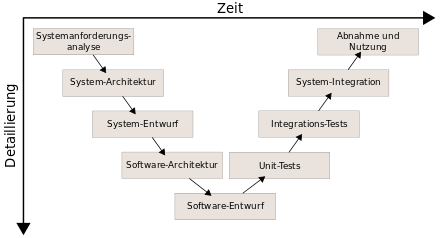V model
The V-model is a process model that was originally designed for software development. Similar to the waterfall model , it organizes the software development process in phases. In addition to these development phases , the V-Modell also defines the procedure for quality assurance ( testing ) by comparing the individual development phases with test phases. On the left-hand side, a functional / technical specification is started, which is expanded in ever deeper detail into a technical specification and implementation basis. In the top the implementation takes place, which is then tested on the right side against the corresponding specifications on the left side. This creates the eponymous "V", which compares the individual development levels with their respective test levels.
This approach was first proposed by the US software engineer Barry Boehm in 1979 and is based on the waterfall model : The phase results are binding specifications for the next lower project phase. The left, downward branch for the specification phases concludes with the implementation phase. An extension to the waterfall model are the test phases that follow in time and are shown in the right branch leading upwards. The specifying phases are contrasted by testing phases, which results in a characteristic "V" in the representation, which also gave the model its name. This comparison should lead to the highest possible test coverage , because the specifications of the respective development stages are the basis for the tests ( test cases ) in the corresponding test stages .
For the V-model in general, the number of phases and their names are presented differently in the literature, but always with a 1: 1 comparison of design and test levels.
The general V-model is the basis of development standards such as B. the V-Modell (development standard) of the public sector in Germany.
The V-model in the development of mechatronic systems
Since 2004 at the latest, the V-model has also been used more generally in development processes. The VDI 2206 guideline recommends the V-model as part of the “development methodology for mechatronic systems”. The background to this is the increasing integration of mechanical , electrical and information technology components in mechatronic systems and the associated increase in complexity.
The starting point is usually a specific requirement or a list of requirements in the form of a development order. These requirements also represent the yardstick by which the subsequent product is to be assessed. In the system design, the overall function of the system or the later product is broken down into partial functions. Once the sub-functions have been determined, the solution concept is usually specified separately in the individual specialist disciplines (domains). The specific solutions of the individual disciplines are combined to form an overall system within the framework of system integration and their interaction is examined. In the course of safeguarding properties, the current design is continuously checked against the specified requirements, thereby ensuring that the desired properties match the actual properties. The entire process can be supported by computer-aided modeling and simulation. The result of a completed cycle of the V-model is the "product", which can be a certain degree of maturity (functional model, prototype , pre-series model, etc.) of the planned end product. The V-model is an iterative process that gradually approaches the final solution and is run through multiple times depending on the complexity of the end product.
Further development
By turning to agile methods , concurrent engineering processes and the simultaneous relevance of systems engineering , the V model was further developed into the W model around 2000 . With an early test phase and the integration of simulation processes and statistical methods to avoid errors, the W-model takes measures that can be used to parallelize work steps. It thus serves as an opportunity to embed agile approaches in classic work environments. The term is primarily used in German-speaking countries.
See also
literature
- Paul Alpar, Heinz Lothar Grob , Peter Weimann, Robert Winter: Application-oriented business informatics. Strategic planning, development and use of information and communication systems. 5th revised and updated edition. Vieweg + Teubner, Wiesbaden 2008, ISBN 978-3-8348-0438-9 , p. 318 .
- Thomas Grechenig, Mario Bernhart: software technology. Pearson studies, Munich a. a. 2010, ISBN 978-3-86894-007-7 , p. 375 .
- Ernest Wallmüller: Software quality management in practice. 2nd completely revised edition. Hanser Verlag, Munich a. a. 2001, ISBN 3-446-21367-8 , p. 131 .
- Jan Friedrich, Marco Kuhrmann, Marc Sihling and Ulrike Hammerschall: The V-Model XT For project managers and QA managers compact and clear , Springer-Verlag Berlin Heidelberg 2009, ISBN 978-3-540-76403-8 , e- ISBN 978- 3-540-76404-5 , [1] .
Individual evidence
- ↑ What does the “V” in “V-Modell XT” stand for?
- ^ Association of German Engineers (ed.): VDI 2206 - Development methodology for mechatronic systems . Beuth Verlag GmbH.
- ↑ A. Spillner: From V-model to W-model. Establishing the Whole Test Process. In: Leibniz Information Center for Technology and Natural Sciences University Library. Technical Information Library (TIB) Hanover, 2000, accessed on June 18, 2019 (English).
- ↑ Reiner Anderl, Roland Nattermann, Thomas Rollmann: The W model. Systems engineering in the development of active systems. In: Catalog of the German National Library. Darmstadt University of Technology. Department of Data Processing in Construction, accessed on June 18, 2019 .
- ↑ A. Spillner: The W model. Use the advantages of agile processes in a conservative environment. In: Society for Computer Science. Regional group Bremen Oldenburg. University of Applied Sciences Bremen, May 13, 2003, accessed on June 18, 2019 .

